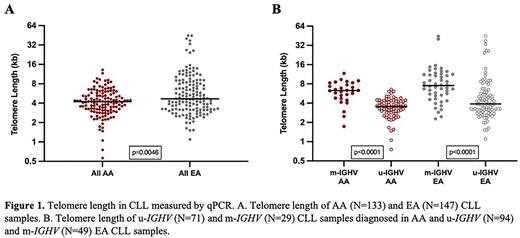Abstract
Background: Chronic lymphocytic leukemia (CLL), a neoplastic disease of relatively mature B-cells, is characterized by a variable clinical course. Although initial studies suggesting more aggressive disease phenotype and inferior clinical outcomes among CLL patients of African ancestry (AA) were published a decade ago, biological features contributing towards this augmented disease severity remain largely unknown. Telomere erosion in a cohort of CLL patients of European Ancestry (EA) has been previously associated with high-risk molecular markers including unmutated immunoglobulin heavy-chain variable region (u-IGHV) status, and genetic alterations such as del(17p) and del(11q) by FISH. Here we characterized telomere erosion in AA CLL patients compared to CLL patients of EA.
Methods: We extracted DNA from CD5+/CD19+ cells peripheral blood mononuclear cells and utilized it to measure the average telomere length through quantitative-PCR (qPCR). Briefly, primers for telomere and the single copy gene (SCG) HBB were used for amplification of 20 ng of DNA in a total volume of 20 µL in triplicates using the KAPA SYBR® FAST optimized for LightCycler®480 and analyzed on a LightCycler®480. Absolute telomere lengths were then obtained by generating standard curves using synthetic oligonucleotide PCR standards for telomere and the SCG gene. The qPCR results were validated by terminal restriction fragment length (TRF) analysis and Southern hybridization (N=28; r=0.8531; p<0.0001) using the TeloTTAGGG Telomere Length Assay. TRF was used as the gold standard of telomere length quantification; however, the high quantity of genomic DNA required for the assay (2µg) limited its broad use. Five CLL samples with known telomere lengths through TRF analysis were included in every qPCR plate in order to perform a linear regression to account for variability between qPCR plates as described previously.
Results: Telomere erosion was evaluated in a cohort of 133 AA (mean age at sample collection 62.7 years ±13.6) and 147 age-matched EA CLL patients (mean age at sample collection 61.6 years ±10.2). The AA samples were collected from 95 (71%) male patients and 71% presented u-IGHV, while EA samples were collected from 110 (77%) male patients and 66% u-IGHV. As expected, we observed shorter telomere length in u-IGHV CLL (median 3.7 kb; range 0.8-44.9) compared to mutated immunoglobulin heavy-chain variable region (m-IGHV) CLL (median 6.8 kb; range 1.8-44.7; p<0.0001) in the full cohort. AA CLL presented shorter telomere lengths (median 4.2 kb; range 0.6-13.1) when compared to EA CLL (median 4.7 kb; range 1.1-44.9; p=0.005; Figure 1A). We highlight that the differences in telomere length observed were restricted to the CD5+/CD19+ cells, with no difference observed in germline samples collected from AA and EA patients. When stratifying by IGHV mutation status, shorter telomere length was observed in u-IGHV when compared to m-IGHV among both AA CLL (median 3.5 kb and 6.3, respectively; p<0.0001) and EA CLL (median 3.9 kb and 7.5, respectively; p<0.0001; Figure 1B). The significant shorter telomere lengths in AA CLL remained significant (p=0.006) after accounting for IGHV status, age, sex, number of mutated CLL driver genes, and Rai stage in multivariate analyses.
Conclusions: Our results demonstrated increased telomere erosion in AA CLL compared to EA CLL, even after accounting for other known prognostic factors. Telomere length has been described as an independent prognostic factor in multiple cancers. In CLL, telomere shortening can lead to a selective pressure for loss of function of DNA damage checkpoint genes, becoming permissive to further cell proliferation and telomere shortening. Future studies are needed to see if these findings contribute towards the severe clinical outcomes in AA CLL compared to EA CLL.
Disclosures
Parikh:Merck: Consultancy, Research Funding; AbbVie: Consultancy, Research Funding; Phamacyclics: Consultancy, Research Funding; Ascentage Pharma: Research Funding; TG Therapeutics: Research Funding; Adaptive Biotehcnologies: Consultancy; GlaxoSmithKline: Consultancy; Genetech: Consultancy; AstraZeneca: Consultancy, Research Funding; Janssen: Research Funding. Kay:MEI Pharma: Research Funding; Sunesis: Research Funding; TG Therapeutics: Research Funding; Tolero Pharmaceuticals: Research Funding; Genentech: Research Funding; Celgene: Other: Data Safety Monitoring Committee, Research Funding; Rigel: Other: Data Safety Monitoring Committee; Morpho-sys: Other: Data Safety Monitoring Committee; Dren Bio: Other: Data Safety Monitoring Committee; AbbVie: Membership on an entity's Board of Directors or advisory committees, Research Funding; AstraZeneca: Membership on an entity's Board of Directors or advisory committees, Other: Data Safety Monitoring Committee; Beigene: Membership on an entity's Board of Directors or advisory committees; Behring: Membership on an entity's Board of Directors or advisory committees; Cytomx Therapy: Membership on an entity's Board of Directors or advisory committees, Other: Data Safety Monitoring Committee; Dava Oncology: Membership on an entity's Board of Directors or advisory committees; Janssen: Membership on an entity's Board of Directors or advisory committees, Other: Data Safety Monitoring Committee; Juno Therapeutics: Membership on an entity's Board of Directors or advisory committees; Oncotracker: Membership on an entity's Board of Directors or advisory committees; Pharmacyclics: Membership on an entity's Board of Directors or advisory committees, Research Funding; Targeted Oncology: Membership on an entity's Board of Directors or advisory committees; BMS: Other: Data Safety Monitoring Committee, Research Funding. Cerhan:BMS/Celgene: Research Funding; Genentech: Research Funding; GenMab: Membership on an entity's Board of Directors or advisory committees, Research Funding; NanoString: Research Funding; Protagonist: Membership on an entity's Board of Directors or advisory committees. Furman:AbbVie, AstraZeneca, Beigene, BMS, Genentech, Janssen, Loxo, MEI Pharma, Pharmacyclics, Sanofi, TG Therapeutics, X4 Pharmaceuticals: Consultancy. Brander:TG Therapeutics: Consultancy, Research Funding; MEI Pharma: Research Funding; Ascentage (transitioning): Research Funding; AstraZeneca/Acerta: Research Funding; NeWave: Research Funding; ArQule/Merck: Consultancy, Research Funding; BeiGene: Research Funding; DTRM: Research Funding; Juno/Celgene/BMS: Research Funding; CATO/SMS Catapult: Research Funding; Genentech: Consultancy, Research Funding; AbbVie: Consultancy, Research Funding; Pharmacyclics: Consultancy, Research Funding; Pfizer: Consultancy. Chesi:Abcuro, Palleon Pharmaceuticals, Pi Therapeutics.: Patents & Royalties: Genetically engineered mouse model of myeloma.; Pfizer, Novartis.: Consultancy.
Author notes
Asterisk with author names denotes non-ASH members.


